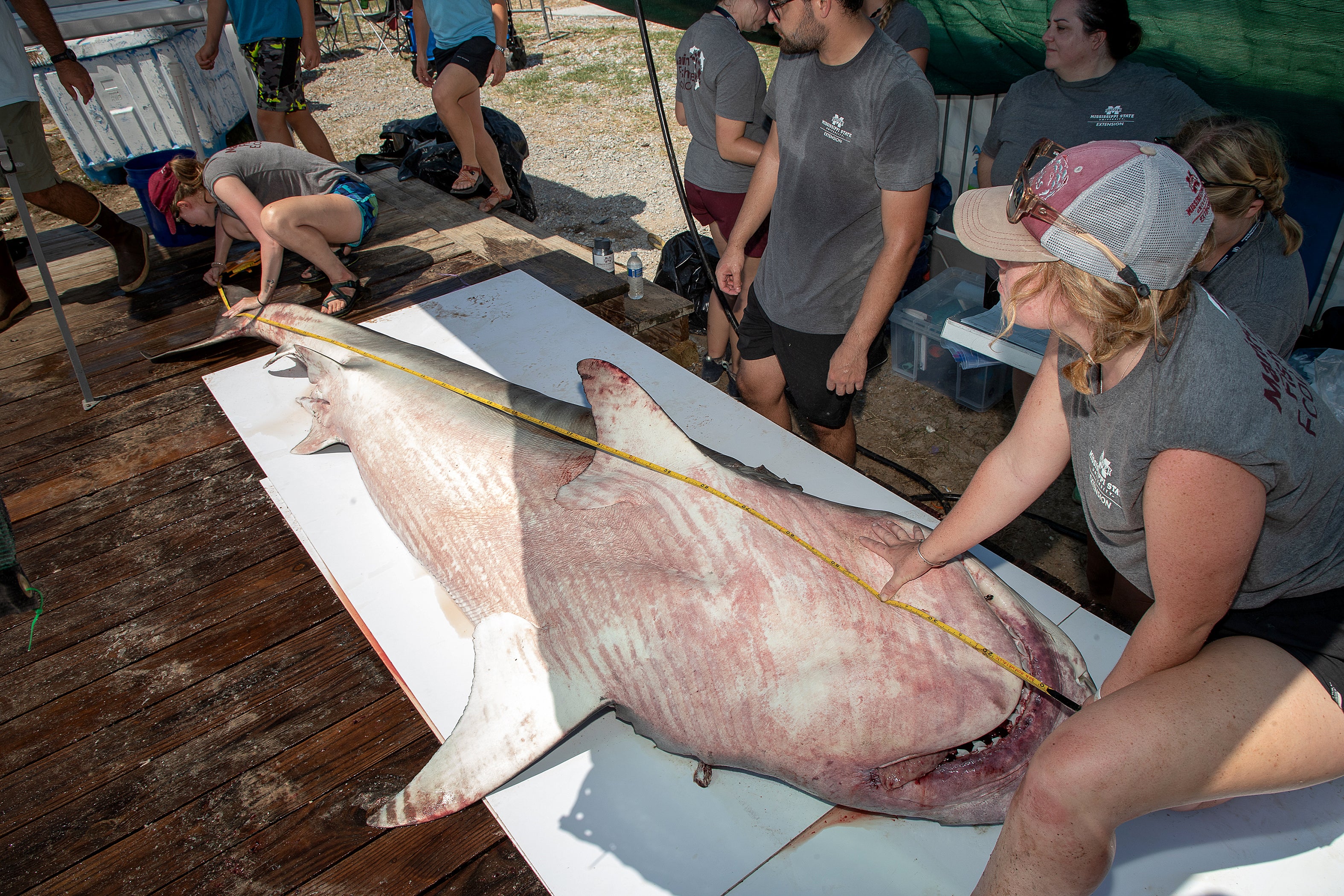By DAVID RAINER, Alabama Department of Conservation and Natural Resources
The return of the shark category to the 89th annual Alabama Deep Sea Fishing Rodeo (ADSFR) was a rousing success with 15 sharks weighed in during the three-day event, with one riding the ferry from Fort Morgan in the back of a pickup to get to the rodeo site on Dauphin Island.
Tiger sharks pretty much reigned taking the top nine places on the leaderboard. James Mullek-Russell weighed in a 674.2-pound tiger to win the category, followed by Ethan Miller’s 658.4-pounder and Brett Rutledge’s 630.8-pounder. The top bull shark of the rodeo was a 434.2-pounder weighed in by Eric Vandrlessche.
As excited spectators and anglers waited for the sharks come to the weigh station, a bevy of marine scientists and students waited to advance the science on these predatory species.
Assistant rodeo judge Dr. Marcus Drymon of Mississippi State University and Mississippi-Alabama Sea Grant Consortium is renowned for his knowledge of the shark species in the northern Gulf of Mexico. He said sharks weighed in at the rodeo certainly provided a unique opportunity to gather a variety of samples from each species.
“I’ve been researching sharks in the north-central area of the Gulf along with Dr. (Sean) Powers for almost 20 years,” Drymon said. “A lot of the research we do is tracking their trends, their relative abundance and distribution as well as doing studies on their age and growth, reproduction, movements and migrations, post-release mortality and things of that sort.
“Here at the Alabama Deep Sea Fishing Rodeo, we’re taking the opportunity to take vertebrae from these very large individuals.”
Sharks don’t have bones; their skeletons are completely made up of cartilage. However, Drymon said scientists have a way of aging these fish other than counting the growth rings on the otoliths (ear bones) that are present in most fish species.
“Their vertebrae are calcified but not completely ossified,” he said. “It’s kind of a fine line, but technically speaking, sharks have no bones. The cartilage in their backbones and the cartilage in their jaws are the closest they have to true bones. Sharks don’t have otoliths like a bony fish. That’s how you determine the age of, say, a red snapper. Since we don’t have those, we use the next best things, which are the vertebrae. We section those and count the concentric band pairs to age those fish.”
Drymon said the scientists were able to gather samples from the reproductive organs, fins, livers and muscle tissue. Samples of bile, gall bladders and kidneys also were taken to assess overall health.
“We look at their stomachs, but they are usually empty,” he said. “They’ve evacuated their stomachs during the process of being captured.”
Most of the sharks weighed at the ADSFR were males, which are usually similar in length to but weigh less than the females, Drymon said. The rodeo placed stringent length requirements on the shark category with an 80-inch minimum for tiger, bull and hammerhead sharks and a 60-inch minimum on blacktips.
“These sharks are great samples, especially because they are the larger individuals of those species, so they’re a little more rare in the population,” he said. “So, for example, having the vertebrae from those individuals is very valuable in trying to determine the maximum age of that species.”
Drymon said the impact of the rodeo harvest will have a minimal effect on the shark populations.
“For the species being caught, their populations in the north-central Gulf of Mexico are in good shape,” he said. “We know this because we’ve seen their population trajectories slowly increase after decades of overharvesting. Due to strong management measures from NOAA Fisheries and the State of Alabama, we see these shark populations are starting to recover and can stand a limited, sustainable harvest.”
Of course, sharks weren’t the only species being studied. Marine scientists gathered samples from a variety of fish during the rodeo, which experienced near-perfect fishing conditions with calm seas and diminishing squalls.








